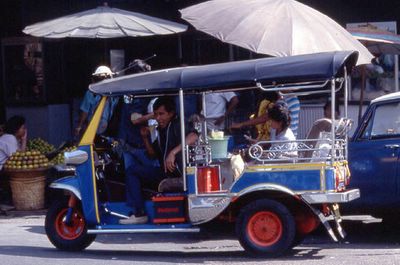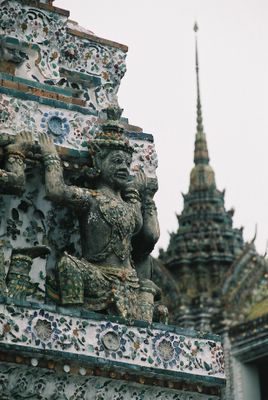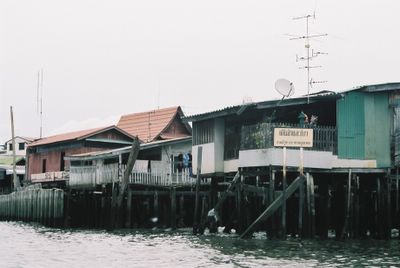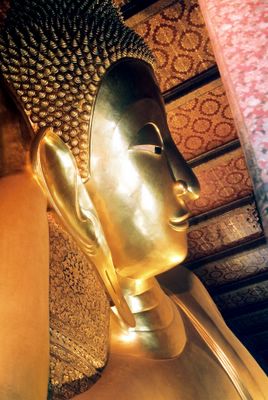Thailand, Part 2: Bitten Ears, Khlongs, and Reclining Buddhas
Our first big evening out in Bangkok was a blur. Everything started off at a gigantic open-air Beer Garden not far from Patpong market. It was massive, it could easily seat thousands and was ringed by scores of food stalls. We found a seat near the middle of this stadium-sized eatery while swarms of pretty Thai girls representing beer companies lobbied for our drink orders. We settled on a tube of Chang beer, our third Thai beer – not as good as Singha, but cheaper and just as strong. I say “tube” because, although it wasn’t much larger than a Canadian pitcher, it was served in a clear plastic tube balanced on a base, with a tap to dispense beer at the bottom. Gravity did the rest (this is one of the things I should have taken a picture of and didn’t).
We gorged ourselves on some Thai curries and a whole sea bass (served with its head intact) while we sat at the table and listened to some truly god-awful Thai pop-singers. We couldn’t believe how bad the music was – let’s just say I can’t wait for future episodes of Thai Idol, coming soon to CTV. As we were leaving, we witnessed another popular Thai pastime: singing Karaoke in enclosed cubicles not much larger than phone booths. And here I was thinking that Karaoke was all about inflicting your singing on other people. They looked like they were having fun though.
From there, we were off to Patpong Market by Tuk-Tuk. What’s a Tuk-Tuk, you ask? Imagine an old-fashioned motor-scooter. Okay, now put three wheels on it, slap a roof over top, and then put a bench seat big enough to seat 3 people across the back. Top it off with some blinking lights, the smell of gasoline, a little dancing-girl figurine dangling from the rearview mirror, and you’ve got a tuk-tuk. Essentially, they’re a cheap alternative to taking a taxi, provided you don’t mind weaving through traffic at high speed in an unstable, open-sided vehicle with nothing but a metal bar to hang onto for dear life. At this point, I learned not to worry about things like tuk-tuks and to relax and enjoy it. Honestly, you have to. If you don’t, you’ll worry yourself sick and you’ll never have a good time there. Yeah, by our standards, they’re pretty unsafe….but I also thought they were a lot of fun. My first ride felt not too much different from the feeling you get riding a rickety portable roller-coaster at a fair (Super-Ex all over again!).

If Chatuchak was our first exposure to true Thai-style information overload, Patpong took it one step further. Patpong is Bangkok’s most notorious (and largest) go-go bar district, and home to just about every Thailand sex-trade rumour you’ve heard about. Oh yeah, there’s also a night market there, but I doubt that many of the foreigners we saw walking around were looking for carved elephants or fine silk goods.
It was here that learning our first words in Thai was essential: “mai ao” (my-ow), meaning “not one” and extended to “not interested,” and the politer version, “mai ao krup” (my-ow-cup, my-ow-ka for the ladies), meaning “No thanks.” (Side note, we used these phrases, and the Thai words for “thank-you,” more than any other phrases while we were there. We used them a lot). We didn’t feel like we had to be polite in Patpong. It was like St-Catherine Street in Montreal on speed.
Everywhere you looked, there were neon signs for three-storey go-go bars (the higher you went, the naughtier they got). There were people handing out flyers telling you what the girls would do at their clubs. There were people trying to grab you by the arm to pull you inside. There were “ladyboys” (I don’t think I need to explain that one). And it went on and on, for blocks. And of course, you can’t go to Patpong without seeing inside at least one of these clubs…
Much like the market outside, the go-go bars are all about volume - at some point in the past, an enterprising club-owner must have asked “why should I put one girl on stage when I can have 25!” And then the rest of the clubs followed suite. Again, it was overwhelming. Unlike clubs here where the dancers have “names” like Candii or Ecstasy, in Bangkok, they wear numbers so that, should the urge strike you, you could order your very own dancing girl by filling out a card.
Of course, this kind of environment makes the go-go girls pretty competitive. Mike got targeted by a particularly aggressive girl at one point. At first, it was relatively innocent...until, without warning, she bit his ear. HARD. I can’t imagine who would appreciate that, but suffice it to say, Mike wasn’t a fan. After checking to see if she had drawn blood, we paid for our drinks and made our way out of the district.
Another tuk-tuk and we arrived at a more conventional club. There were still subtle differences. We negotiated our cover in by agreeing to buy a bottle of whisky for the table. While we were enjoying a surprisingly talented foreign cover-band, Rachel’s Mike (who we’ll call Mikey from here on in, not because he goes by Mikey, but because it just makes things easier) pointed out a corner of the bar which was known to be frequented by Russian prostitutes. And there they were! Apparently that sort of thing is matter-of-fact in Bangkok. We spent the rest of the night dancing after the band did a kick-ass version of the Black Eyed Peas, almost as good as the real thing.
The next morning, we stopped at a street vendor to get some breakfast. Like with souvenirs and t-shirts and the like, wherever you look on city streets, you’ll see people selling and cooking food. Some might be what you might expect – fresh cut mangoes, melon, and papayas, soups, curries, skewers of meat in spicy sauce, spring rolls, etc. – but some are a little more exotic. Skewers with whole fish, mini-octopus, and other “meat products” were pretty common, all cooked over a small BBQ-like charcoal burner and served in clear plastic baggies with toothpicks for utensils. Even sauces came in baggies. Often these stalls are portable, fixed to carts, bicycles, motorcycles, or even boats, to get them to where people are hungry.
We made a bee-line to the Chao Phraya River, the life-giving vein of the ancient city of Bangkok, to see a man about a boat. One of the things Rachel rightfully insisted on was to take us on a tour of the river by Khlong, or longtail boat. Khlongs are long, slim wooden boats with several rows of seats for passengers. But their most notable feature is that they’re powered by an engine torn straight out of a car. So these engines are fixed on the back of the boat on a pivot…and the drive shaft coming out of it, instead of connecting to an axle, has a propeller on the end of it. The operator muscles around the naked engine with a lever to steer the boat, sitting inches away from a sharp, spinning cooling fan. Gutsy.

Our first stop on the tour was Wat Arun, the Temple of the dawn ("Wat"=Temple). The main spire is massive, probably ten-stories tall.

Although Wat Arun was one of the less well-maintained that we visited, the level of detail was extraordinary. All of those individual dots you see are all individual ceramic tiles. The entire structure was also encrusted in statues like this one. It kinda speaks for itself.

Another short sprint by boat and we toured the National Royal Barge museum. No pictures here (they were charging extra admission if you wanted to take any). But the barges were incredible, fully carved from wood and inlaid with gold and gem stones, used by Thailand’s royalty for special events. Check out this link if you’d like to see what they’re like.

The rest of the tour brought us down various waterways off the main course of the river, and it was here that we really understood why Bangkok is known as the Venice of the East. The canals are lined on both sides with houses built on stilts above the water and we saw people fishing and swimming along the route. We passed a floating restaurant and 20-or-so Wats, bought drinks from a lady in a boat who pulled up next to ours, and fed bread to two-foot-long catfish (sold to us by way of a bucket lowered down from above) before heading back to the dock where we started the tour.

From there, we made our way to Wat Pho, Bangkok’s oldest and largest temple and one of its earliest centres of higher education. But most importantly, it is also the home of the 150-ft long "Reclining Buddha" statue, built from plaster and brick and gilded with gold leaf. It was awe-inspiring. For good luck, we made 100 donations in 100 pots, all placed in a row.

While we were there, we learned that the spires, known as “chedi,” found at every Wat were actually burial monuments. Wealthy families make donations to the Wat in return for the honour of being able to house their family members' ashes beneath the spires - the bigger the spire, the bigger the donation the families are responsible for. And many of the statues seen around the Wats were often there because they were used as ballast on trading boats coming from China. Our guide was awesome and told us tons about Buddhism and temples that we never would have figured out on our own. Our guide books didn’t even come close.

Wow, was hoping to get a little further than this, but I guess the early posts need those extra bits of description to help flesh out what the experience was really like. Watch out real soon for Part 3: "Parks with Soundtracks, Disco-ball Volkswagons, and 8 Pairs of Socks."


1 Comments:
Holy Crap,
Andrew Limmert is that you? Nathan Adams here. Yeah, read the name again slowly and it may come to you. A friend of mine was telling me about Blogger.com and said he'd seen this good example with lots of pictures and stuff while surfing. I didn't read the link carefully until I saw your picture. How the hell are you? I hope this note finds you well, by the look of your site, it does.
Oh - you can e-mail me, if you are so inclined at:
nathan.adams@mail.mcgill.ca.
Cheers!
N.
Post a Comment
<< Home